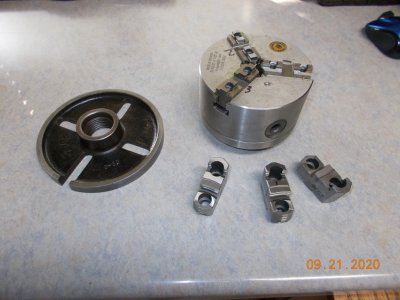- Joined
- Dec 20, 2012
- Messages
- 9,422
As noted above, a set-tru chuck allows you to dial out run out of the chuck. However, and this is important to understand, a 3 jaw scroll chuck is usually used for first operations, the first turning on a work piece. It doesn't matter if the work piece is rough stock or whatever; the first time you turn it is a first op. As long as that work piece is not removed from the chuck and you turn it to completion, it will have zero run out. The vast majority of the work done on a lathe is like this. Once you remove that work piece from the chuck or part it off and then have the need to machine it further (called a second operation) then that same piece will run out like crazy if you put it back in a 3 jaw chuck. A 3 jaw set-tru chuck will allow you to dial that work piece back in with fair accuracy.
EDIT: I should clarify. A set-tru chuck has 3 or 4 set screws let into the backplate of the chuck. Those set screws bear on a snout in the back of the chuck. To adjust the chuck's run out, you loosen the mounting screws that hold the chuck to the back plate and use those set screws to move the chuck around on the back plate to minimize run out. Once you adjust it, you lock down the mounting screws and you're set. Note that this adjustment only applies to that specific work piece. If you mount another work piece for a second op, you will have to readjust the chuck again. A set-tru chuck can be made to run accurately for a single diameter; it is not a uber-chuck that is accurate for everything.
Just know that a 4 jaw independent chuck will dial that same work piece in more accurately. A collet chuck will come close to it and do it much faster.
My suggestion to you is to buy a standard 3 jaw like I linked to. A set-tru will cost a lot more. When you must be accurate on a second op, use a 4 jaw chuck and you will be both dollars and accuracy ahead.
EDIT: I should clarify. A set-tru chuck has 3 or 4 set screws let into the backplate of the chuck. Those set screws bear on a snout in the back of the chuck. To adjust the chuck's run out, you loosen the mounting screws that hold the chuck to the back plate and use those set screws to move the chuck around on the back plate to minimize run out. Once you adjust it, you lock down the mounting screws and you're set. Note that this adjustment only applies to that specific work piece. If you mount another work piece for a second op, you will have to readjust the chuck again. A set-tru chuck can be made to run accurately for a single diameter; it is not a uber-chuck that is accurate for everything.
Just know that a 4 jaw independent chuck will dial that same work piece in more accurately. A collet chuck will come close to it and do it much faster.
My suggestion to you is to buy a standard 3 jaw like I linked to. A set-tru will cost a lot more. When you must be accurate on a second op, use a 4 jaw chuck and you will be both dollars and accuracy ahead.
Last edited:


